Eugène Delacroix Painting Greece on the Ruins of Missolonghi Meaning
 |
| Greece on the Ruins of Missolonghi by Eugène Delacroix (1826) |
Painting of Eugène Delacroix Greece On the Ruins of Missolonghi Analysis
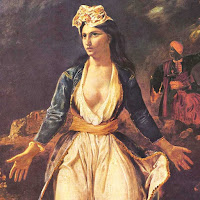 |
| Greece on the Ruins of Missolonghi Detail of Greek Woman |
 |
| Liberty Leading the People Detail of La Marianne |
 |
| The Statue of Liberty by Frédéric-Auguste Bartholdi and Gustave Eiffel (1886) |
 |
| The Raising of Lazarus by Rembrandt (1630-1632) |
 |
| Greece on the Ruins of Missolonghi Detail of Ottoman Janissary |
 |
| Napoleon I on His Imperial Throne by Jean Ingres (1806) |
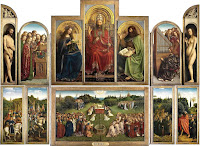 |
| Ghent Altarpiece by van Eyck Brothers (1420-1432) |
Missolonghi Massacre and Greek War of Independence in Eugène Delacroix Artworks
 |
| Pietà by Michelangelo (1498-1499) |
 |
| Portrait of Victor Hugo by François-Nicolas Chifflart (1868) |
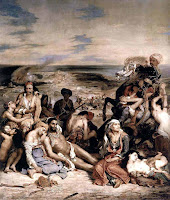 |
| The Massacre at Chios by Eugène Delacroix (1824) |
 |
| Scene from the War Between the Turks and Greeks by Eugène Delacroix (1856) |
 |
| Portrait of Lord Byron by Richard Westall (1813) |
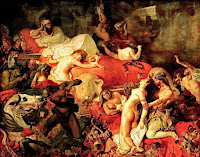 |
| The Death of Sardanapalus by Eugène Delacroix (1827) |
 |
| Illustration of Lord Byron by Alfred Joseph Stothard (1826) |
The romantic painter’s style was contradictory and complete.
He availed himself of Baroque lightning from the historical paintings of Peter Paul Rubens and the lithographs of Théodore Géricault in order to create
realistic canvases, however most of them can be defined as riot of colors.
Beyond lighting that he learned from Rubens, the artist created a convincing
effect on the audience with the combination of vivid and smooth colors, while
he also determined a revolutionary style by combining secular and religious
symbols together. While the baroque chiaroscuro technique needed to tell
strikingly the historical events including the results of the conflict between
the Roman Catholic Church and protestants at this period, it has been used for
the depiction of any kind of sujects in Baroque Era paintings, such as David
and Goliaths (Madrid, Vienna, Rome) by Caravaggio Merisi. Delacroix utilized
the extraordinary effect of this technique as a propaganda tool for nationalist
politics and revolutionary ideas.
The Third Siege of Missolonghi Greece
 |
| Portrait of Lord Byron in Albanian Dress by Thomas Phillips (1813) |
Greece Expiring on the Ruins of Missolonghi Lagoon
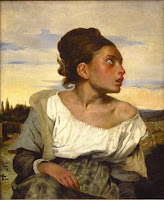 |
| Orphan Girl at the Cemetery by Eugène Delacroix (1823-1824) |
Greece Expiring on the Ruins Of Missolonghi Significance and Legacy
 |
| Greece on the Ruins of Missolonghi Detail of Eugène Delacroix’s Signature |
 |
| Women of Algiers in their Apartment by Eugène Delacroix (1834) |
 |
| Self-Portrait by Eugène Delacroix (1837) |
Greece on the Ruins of Missolonghi by Eugène Delacroix
 Reviewed by Articonog
on
July 25, 2022
Rating:
Reviewed by Articonog
on
July 25, 2022
Rating:
 Reviewed by Articonog
on
July 25, 2022
Rating:
Reviewed by Articonog
on
July 25, 2022
Rating:





No comments: